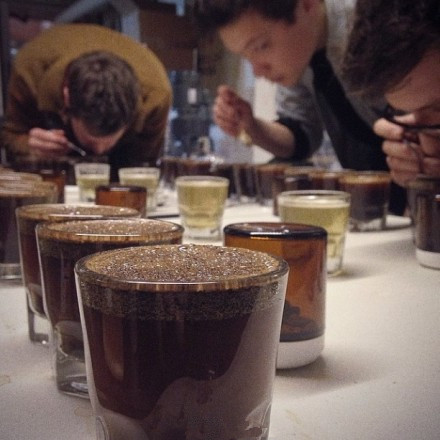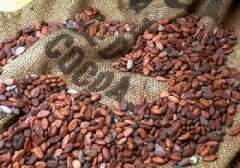Coe cup meter Osher Chinese version description coffee cup test
The cup testing system introduced by BGT and Osher Coffee Alumni Association in the past two years all use the CoE competition mode. At present, the fine bean competition in various countries uses either CoE or SCAA mode, up to 9 major coffee producing countries all use the Coe cup as the national competition mode, so we decided to promote the CoE cup testing system in Taiwan.

The purpose of BGT is to let barista [understand boutique coffee] and use his superb technology to make the best products to make customers satisfied! In order to understand the quality of fine coffee, we must learn how to identify the quality. Learning cup testing is an important technology to identify the quality. The cup testing technology has gradually changed from the learning option of barista and coffee industry to one of the necessary technologies. This change is benign and a sign of the progress of the coffee industry.
At the end of the two-year course, we found that the English version of the Coe Cup meter made some beginners feel a little difficult, so we specially used the early CoE Chinese version of the Osher Alumni Association, and explained the eight important comments and the quality significance of the scores. The following is the key description of the evaluation items and records of the Osher Coe Cup, which can give you a basic basis when testing the cup. At the same time, when testing a single evaluation, you can also assist in the reference:
Aroma-at this time, the cup test has just begun the first evaluation item, there are a total of three aroma evaluation stages, the first stage is the cup test at the beginning to smell the dry powder in the cup, the second is to smell the surface aroma after water injection, and the third aroma is the broken residue aroma heard at the time of broken residue. Aroma is an attractive element of coffee, coffee aroma from many sources, including flowers, berries, caramel, nutty, chocolate, spices and so on.
The aroma of the Coe Cup meter is only included in the reference and does not include the total score, but in the Flavor evaluation, the aroma is included in the score.
The first score item: cleanliness, Clean cup
Cleanliness is a very important and necessary condition for fine products, so cleanliness is the defective taste without defects and stains (complete freedom from taints or faults), coffee is rotten, earthy, iodine, fermented acid, rubber, onions, astringency and other bad taste and touch, all indicate that it is not clean enough.
The second score item: sweetness, Sweetness
Sweetness not only represents that coffee cherries are harvested in the best ripening period, without unripe beans, but also represents the excellent quality of coffee. Only by selecting freshly ripe coffee cherries to treat them into raw beans can we get better sweetness, and there are many kinds of sweetness, such as sugarcane sweetness, caramel sweetness and so on, which can be confirmed in comparison. If sweetness is astringent, sweet stays in the mouth for a short time. The sweetness score will not exceed 6.
The third score item: acid quality, Acidity
Sour, good acidity is not like vinegar, even if it is bright and lively, you can detect many kinds of acidity, such as citrus, berries or sweet lemons, as well as the sweet and sour melons like cantaloupe or the crisp acidity of freshly ripe apples. The above acids are of high quality; bad acids are like unripe fruit or acetic acid, some bad acids are like overripe fruit or rotten fruit, fermented acid or rotten acid can be detected. Http://www.coffeebug.org
Fourth score item: oral tactile sensation, Mouth feel
The tactile evaluation of the mouth is not to measure the taste, but the substances and tactile sensation, the sense of grease, the viscosity, and the sense of quality all constitute the mouth-feel;, such as milk and water. The tactile sensation of the former is much higher, and the consistency and tactile sensation of thick soup and clear soup are much higher than those of the latter.
The fifth item is the important sipping flavor, Flavor.
-sipping flavors, including a variety of tastes and smells, even the aroma felt in the nasal cavity and the touch of the mouth belong to this category. When testing CoE cups, because 8 samples are often tested at a time, the AROMA item cannot be measured immediately, so at the beginning, the aroma is only marked by pleasure and displeasure, but when sipping wind is used as this evaluation, cup testers can include the aroma they feel, including all kinds of flavors tested or drunk. It can be said that sipping flavor is a very important evaluation, and it is also a basis for testing the characteristics of coffee samples.
The sixth item, Yuwei, Aftertaste
After sipping, the taste or aroma or touch that still stays in the mouth, and the good flavor stays for a long time, such as sweetness, remains clearly in the mouth or even scattered after sipping and spitting coffee, then the score of this item will be high, on the contrary, it is not tasty, or very short, the score is low.
The seventh item, the degree of balance Balance
Refers to whether each evaluation of coffee is balanced, for example, although the acid is bright, it still turns sweet? The touch is sticky but not astringent?
Are the various flavors of coffee harmonious? If so. Then the score of this item will be high.
The eighth item: overall evaluation, Overall
Coffee is excellent on the whole and attracts you? Is it just so-so, or do you not like her at all?
This evaluation is the overall assessment of the tester, and can also reflect his personal preferences.
The total score after the cup evaluation, the significance represented, and the standard represented by the individual score:
1) the CoE scale has eight items, the highest score of each item is 8 points, the lowest score is 0 points, and the weighted score is 36 points, so the total score is 100 points.
2) 6 indicates that the project reaches the standard of CoE competition level, which belongs to good quality (fine). If it is totally unacceptable, give 0 (unacceptable), if the quality is ordinary, 4 (Poor), and if it is excellent or even perfect, give 8 (great).
3) the discrimination of total score:
If the total score is between 70 and 79, this sample is generally a better commercial bean.
If the total score is in the range of 80,83.5, this sample belongs to fine coffee.
If the total score is more than 84, this sample belongs to the CoE competition level, that is, the high level of winning beans.
Important Notice :
前街咖啡 FrontStreet Coffee has moved to new addredd:
FrontStreet Coffee Address: 315,Donghua East Road,GuangZhou
Tel:020 38364473
- Prev

Decaffein, the processing method of low caffeine coffee beans
CO2 low-caffeine treatment and other low-caffeine treatments are described as follows: at present, there are three ways to remove caffeine from coffee beans: 1. Water treatment can remove 9496% of the caffeine. 2. Chemical extraction method, early use of chloroform (Chloroform) and benzene (Benzene) as solvents to extract caffeine, and later understand that these chemicals cause cancer, and then gradually become other low-hazard chemicals.
- Next

Coffee technical terminology Coffee English words collection
Coffee machine, barista-related English words Chinese translation Tamper powder hammer, the iron in the hand of the barista in the coffee shop! ^ _ ^ Portafilter cooking handle, same as above! Basket handle filter, powder bowl, this is integrated with Portafilter brewing handle, coffee powder is placed here, and then hammered with Tamper powder. Mac
Related
- Beginners will see the "Coffee pull flower" guide!
- What is the difference between ice blog purified milk and ordinary milk coffee?
- Why is the Philippines the largest producer of crops in Liberia?
- For coffee extraction, should the fine powder be retained?
- How does extracted espresso fill pressed powder? How much strength does it take to press the powder?
- How to make jasmine cold extract coffee? Is the jasmine + latte good?
- Will this little toy really make the coffee taste better? How does Lily Drip affect coffee extraction?
- Will the action of slapping the filter cup also affect coffee extraction?
- What's the difference between powder-to-water ratio and powder-to-liquid ratio?
- What is the Ethiopian local species? What does it have to do with Heirloom native species?

